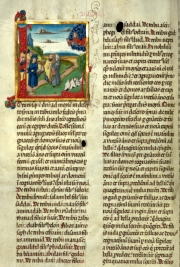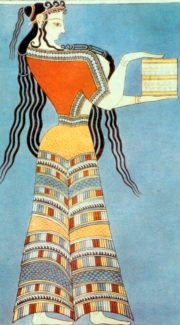 (See Part 1 of this discussion.)
(See Part 1 of this discussion.)
Let’s continue this critique of a podcast titled “Sex, Lies & Leviticus” from apologetics.com that responded to Dan Savage’s criticism of the Bible. Italicized arguments are my paraphrases from the podcast.
“Slavery” in the Bible is simply not the same thing as slavery in the United States. For example, consider Ex. 21:16:
Anyone who kidnaps someone is to be put to death, whether the victim has been sold or is still in the kidnapper’s possession.
See? A rejection of slavery, right there in the Bible.
Nope. This refers just to Jews kidnapping Jews—see the NET Bible comment on this verse. The Bible makes a clear distinction between (1) Jews as slaves and (2) members of other tribes as slaves.
(Why is the atheist educating the Christians about their own book? Don’t they know about these two aspects of biblical slavery?)
“We have a very different view here of what slavery was [comparing American slavery with biblical slavery] and you can see that it’s heavily regulated.”
Yes, slavery was regulated, just like commerce. And, like commerce, slavery was kosher from God’s standpoint.
And yes, Africans enslaved in America was different than Jews enslaved by Jews (but we’ll get to that).
On the podcast, Brooks read the rules for treating Jewish slaves from Exodus 21:2–8. A Jewish slave must be freed after six years; any wife or children that came with him would be free to go, but if the master buys him a wife, she remains behind; if the slave can’t bear to part with his wife, he can remain if he promises to be a slave for life; there are special rules for how to sell your daughter into slavery; and so on.
This is rather like indentured servitude used in the American colonies, the contract by which someone would be transported to the New World in return for five or so years of work. These were European servants working for European masters.
But, incredibly, the discussion didn’t address the elephant in the room: the biblical rules for non-Jewish slavery. This conversation went on for an hour, so it’s not like they didn’t have time. Are they really unaware of this? Or was this a deliberate deception on their part, a wager on the ignorance of their audience?
Well, if they won’t discuss it, I’ll be happy to. Let’s wallow in the Bible’s radically pro-slavery message.
Your male and female slaves are to come from the nations around you; from them you may buy slaves. You may also buy some of the temporary residents living among you and members of their clans born in your country, and they will become your property. You can bequeath them to your children as inherited property and can make them slaves for life, but you must not rule over your fellow Israelites [harshly]. (Lev. 25:44–46)
This doesn’t look like indentured servitude, Toto. Indeed, this looks very much like the slavery for life (chattel slavery) in America that the speakers were so frantic to distance themselves from. The Jews treated the folks from their own tribe better than “those people” from other tribes. Sound familiar?
Much is made in the Old Testament of how God rescued the Jews from slavery in Egypt, but slavery was a terrible burden only when applied to us. When it’s applied to them, that’s a very different story. In fact, the Jews enslaved the tribe of the Gibeonites as soon as they returned to Canaan after the exodus from Egypt (Joshua 9:23).
More biblical advice on slavery:
When you march up to attack a city, make its people an offer of peace. If they accept and open their gates, all the people in it shall be subject to forced labor and shall work for you. (Deut. 20:10–11)
You could argue that slavery is better than being killed, which the following verses make clear is the alternative. Indeed, the hosts make points like this—slavery is better than dying, slavery is the merciful alternative, Old Testament rules were kinder than those in some neighboring countries, and so on.
But I gotta wonder—is this is the best that can be said about the greatest moral document in history, that it wasn’t as bad as the morality in surrounding countries? This is the best an omniscient, omni-benevolent God can do?
Speaking of forced labor, this is how King Solomon worked his famous mines (1 Kings 9:20–22).
Then there’s the category of sex slaves (or sex workers or concubines or whatever):
Now kill all the boys. And kill every woman who has slept with a man, but save for yourselves every girl who has never slept with a man. (Num. 31:17–18; see also Deut. 21:11)
And no slave manual would be complete without a rule for how to beat slaves correctly:
If a man beats his male or female slave with a rod and the slave dies as a direct result, he must be punished, but he is not to be punished if the slave gets up after a day or two, since the slave is his property. (Ex. 21:20–21)
Again, this sounds very much like slavery in America. These biblical laws sound similar to the laws governing the practice of slavery in America. Some of these also protected slaves. For example, the 1739 South Carolina code fined someone who killed a slave £700 and limited the number of hours that slaves could be made to work. The 1833 Alabama law code dictated, “Any person who shall maliciously dismember or deprive a slave of life, shall suffer such punishment as would be inflicted in case the like offence had been committed on a free white person.”
Despite the hosts’ protestations to the contrary, American slavery and biblical slavery were quite similar institutions.
Continue reading: Part 3
He that will not reason is a bigot;
he that cannot reason is a fool;
he that dares not reason is a slave.
— William Drummond
Photo credit: Wikimedia

 We’re taking a trip through time, from our English New Testament, back through the translations and various copies (
We’re taking a trip through time, from our English New Testament, back through the translations and various copies ( The Trojan War of roughly 1200 BCE and the destruction of the city of Troy, about which Homer wrote the epic Iliad, was monumental enough in itself, but that period also marked the end of the Mycenaean Greek civilization. The Linear B writing system of the time was abandoned, never to be revived, and most of Greek cities of the time were destroyed or abandoned. Only after centuries of relative barbarism did the Greek city-states of Sparta, Corinth, Athens, and so on appear.
The Trojan War of roughly 1200 BCE and the destruction of the city of Troy, about which Homer wrote the epic Iliad, was monumental enough in itself, but that period also marked the end of the Mycenaean Greek civilization. The Linear B writing system of the time was abandoned, never to be revived, and most of Greek cities of the time were destroyed or abandoned. Only after centuries of relative barbarism did the Greek city-states of Sparta, Corinth, Athens, and so on appear.
 Hey gang! This has been great fun, but today is the last day for this blog. Of course, that’s because this is the last day for everything. God ends the world today.
Hey gang! This has been great fun, but today is the last day for this blog. Of course, that’s because this is the last day for everything. God ends the world today.